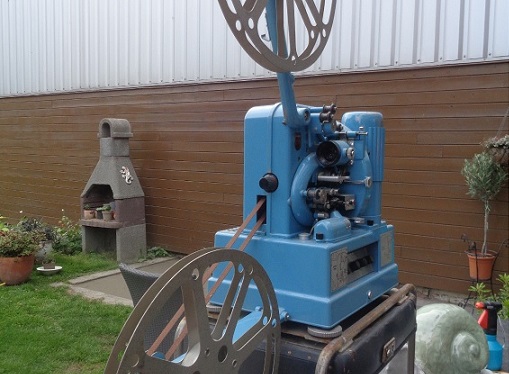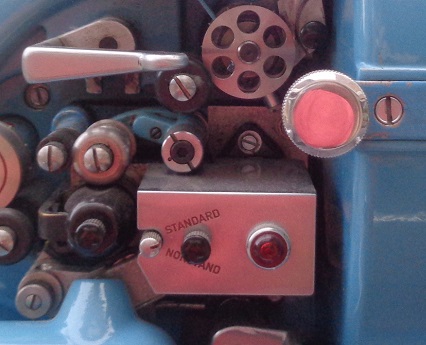This is topic Philips EL 5000 in forum 16mm Forum at 8mm Forum.
To visit this topic, use this URL:
https://8mmforum.film-tech.com/cgi-bin/ubb/ultimatebb.cgi?ubb=get_topic;f=5;t=001872
Posted by Nick Vermeirsch (Member # 4136) on September 15, 2018, 12:54 PM:
Hello everyone
Does anyone has an idea about the meaning of the "standard" / "nonstand" function knob on my "blue sky" Philips EL 16 mm projector? I have no cables nor manual and he has never been running, so i have not found it out, but curious to know ![[Wink]](wink.gif)



Posted by Tom Photiou (Member # 130) on September 15, 2018, 01:17 PM:
I cant help you on your enquiry but what a great looking projector that is. ![[Wink]](wink.gif)
Posted by Maurice Leakey (Member # 916) on September 15, 2018, 02:49 PM:
Nick
The control seems to be at the sound head. If so, the control is to move the optics to read the sound track on the reverse side of the film.
Some 16mm prints are dupes so their emulsion is not on the standard side. It's only a superior control to achieve the best sound quality.
Posted by Lindsay Morris (Member # 3812) on September 15, 2018, 10:42 PM:
Maurice is correct. The control only slightly moves the slit optics closer or further from the film.
These are VERY nice machines to work with once you get your head around the reverse projection layout where the sound track is outer most when threading up.
They also have a Geneva intermittent sprocket so are very gentle on film particularly any with damaged perfs etc.
Very quiet in operation, easy to clean the gate and some I have seen had spool capacities of 6000 feet reels.
Many were used in Australia for Telecine work and once that ended a few found their way into the hands of collectors in their home cinemas.
Biggest problem was the original Philips lamphouses used 1000 Watt lamps so the light was nowhere near as good as a B&H with a 250W halogen. Due to the quite fat shutter housing it was very hard to get a halogen lamp to be close enough to the gate to get really good light but there were some 120V Halogens (cannot recall type number now) that the "spot" of the light was further from the mirror face than that of the ELC type lamp. So those lamps suited the setup better with the fat shutter housing.
The machines I saw were 110V models so for Aust use with 240V mains one needed a step down transformer and IF you used a hefty one you could use the 110V tapping for the motor and the 120V tapping for the lamp as 110V on a 120V lamp gave inferior light. You had to monkey with the wiring but it was doable.
Posted by Maurice Leakey (Member # 916) on September 16, 2018, 04:53 AM:
I have similar on my Kodak Pageant but the vertical control kept on dropping to its opposite setting due to vibration.
But cured by my great service engineer.
Posted by Nick Vermeirsch (Member # 4136) on September 18, 2018, 12:45 PM:
Thanks all for the useful information! ![[Wink]](wink.gif)
Visit www.film-tech.com for free equipment manual downloads. Copyright 2003-2019 Film-Tech Cinema Systems LLC

UBB.classicTM
6.3.1.2
![[Wink]](wink.gif)



![[Wink]](wink.gif)
![[Wink]](wink.gif)